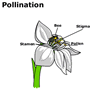Factors affecting survival: Biotic
Other organisms affect an individual's chance of survival in many differing ways.
Co-operation and competition
Members of the same species can alter an individual's chance of survival
by:
-
Co-operation between organisms in a group for protection against
predators, (e.g. schools of fish, flocks of birds), for protection against
the cold (huddling penguins), for hunting efficiency (wolf packs) and
for social organisation (bees, termites and the like). See Animal
groups.
- Competition between organisms for limited resources such as food
(plants compete for water, light and space), nesting sites, territory
(an actively protected area around the nest), and mates. When resources
are limited, those organisms which compete best will survive and reproduce
more offspring like themselves. This is termed "survival of the
fittest".
Most animals will not fight to the death for resources or mates but the weaker one will submit to prevent further harm and wastage of energy .
Competition also explains the importance of dispersal of young to prevent over-crowding and pressure on limited resources.
Effects of other species
Members of other species can also alter an individual's chance of survival
.
"Symbiosis" involves the living together in close association
of organisms from different species. Some types of symbiotic relationships
are:

- Collaboration involves different species
benefiting each other such as birds and insects assisting in flower
pollination by collecting pollen and nectar (see Plant
Systems C: Reproduction and flowering plants) and inadvertently
passing the pollen onto the next flower. This relationship is not necessarily
continuous nor is it always between the same two individuals.
- Commensalism involves a close living
association between two different species where one species is benefitted
while the other is unaffected, e.g. epiphytic ferns growing on tree
trunks.

- Mutualism (mutually beneficial relationships)
involves two different organisms living in a close relationship to the
benefit of both e.g. crab and hydroid (a small anemone-like organism).
The crab is protected and the hydroid gets food. Some organisms live
in a relationship essential to the survival of both. For example, cellulose-digesting
bacteria in a rabbit's gut allows fibre breakdown and the release of
nutrients for the rabbit, as well as food and protection for the bacteria.
- Parasitism invloves organisms which at
some stage of their life cycle live in or on another organism (the host)
having a detrimental effect on the host. (See Parasites).
Other examples of interactions with other species are:
- Competition between organisms for the same food source (e.g. kangaroos and sheep for grass) can decrease survival chance. Those that can utilise alternate resources have an advantage through decreased competition. Possums and parrots compete for nesting sites in hollow logs, though sometimes organisms will "time share" at different times of the year.
- Consumers and predators eat other organisms for food.
- Pests and weeds are animal and plant species not wanted
by humans because they compete more successfully than the desired species.
Introduced species such as the rabbit, fox, European Wasp and blackberry
brought in from other countries often survive and reproduce extremely
successfully due to the lack of natural predators in their new habitats.
(See Introduced species: "Not
in my backyard")
- Disease-causing organisms
(pathogens) reduce survival directly by causing illness, or indirectly
by weakening the organism so that it becomes easier prey for predators.
- Plants can be beneficial to other organisms for shelter (camouflage, protection and shade), for food and nesting material.
| Copyright owned by the State of Victoria (Department of Education and Early Childhood Development). Used with Permission. |
|
|||||||||||||||||||||||